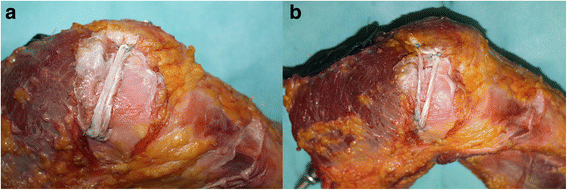Biomechanical comparison of single- and double-bundle medial patellofemoral ligament reconstruction
- PMID: 28193295
- PMCID: PMC5304392
- DOI: 10.1186/s13018-017-0530-2
Biomechanical comparison of single- and double-bundle medial patellofemoral ligament reconstruction
Abstract
Background: Recurrent patellar dislocation is common clinically, primarily in adolescents. However, the biomechanical properties of single- and double-bundle medial patellofemoral ligament (MPFL) reconstruction remain poorly understood.
Methods: Six fresh frozen adult cadaveric knee specimens were obtained for this study. Each specimen was fixed at 0° to test the force needed when the patella was laterally shifted 10 mm at a speed of 0.5 mm/s, and the test was repeated three times. This test was repeated when knee flexion was at 0°, 15°, 30°, 45°, 60°, and 90°. All six specimens were tested in four statuses, including MPFL intact, MPFL torn, single-bundle MPFL reconstruction, and double-bundle MPFL reconstruction.
Results: Similar force is required in these MPFL statuses at 0° of flexion, except for the MPFL torn group with a smaller force (45.5 ± 9.6 N, p < 0.05). The force required in the MPFL torn group reduced from 12.8 to 38.8% compared to other groups, at 0°, 15°, 30°, and 45° of flexion angles. At the flexion of 15°, the double-bundle reconstruction group required a statistically greater force (85.9 ± 10.1 N) compared to the single-bundle reconstruction group (74.0 ± 7.9 N). Interestingly, no statistical difference was found at flexions of 60° and 90° in these four groups.
Conclusions: Both single-bundle and double-bundle MPFL reconstruction can restore the stability of the patella. The double-bundle reconstruction has an angular synergy effect that simulates the MPFL wide footprint in the patella, which enables it to have greater capacity to resist patellar dislocation before the patella entering the femoral trochlea at a smaller flexion angle.
Keywords: Biomechanics; Double bundle; Medial patellofemoral ligament reconstruction; Single bundle.
Figures



Similar articles
-
Ability of Medial Patellofemoral Ligament Reconstruction to Overcome Lateral Patellar Motion in the Presence of Trochlear Flattening: A Cadaveric Biomechanical Study.Am J Sports Med. 2021 Nov;49(13):3569-3574. doi: 10.1177/03635465211041087. Epub 2021 Sep 15. Am J Sports Med. 2021. PMID: 34524034
-
The effect of femoral tunnel position and graft tension on patellar contact mechanics and kinematics after medial patellofemoral ligament reconstruction.Am J Sports Med. 2014 Feb;42(2):364-72. doi: 10.1177/0363546513509230. Epub 2013 Nov 25. Am J Sports Med. 2014. PMID: 24275861
-
Selective bundle tensioning in double-bundle MPFL reconstruction to improve restoration of dynamic patellofemoral contact pressure.Knee Surg Sports Traumatol Arthrosc. 2020 Apr;28(4):1144-1153. doi: 10.1007/s00167-019-05789-5. Epub 2019 Nov 18. Knee Surg Sports Traumatol Arthrosc. 2020. PMID: 31740983
-
Properties and Function of the Medial Patellofemoral Ligament: A Systematic Review.Am J Sports Med. 2020 Mar;48(3):754-766. doi: 10.1177/0363546519841304. Epub 2019 May 15. Am J Sports Med. 2020. PMID: 31091114
-
Recognition of evolving medial patellofemoral anatomy provides insight for reconstruction.Knee Surg Sports Traumatol Arthrosc. 2019 Aug;27(8):2537-2550. doi: 10.1007/s00167-018-5266-y. Epub 2018 Oct 28. Knee Surg Sports Traumatol Arthrosc. 2019. PMID: 30370440 Review.
Cited by
-
[Arthroscopic reconstruction of medial patellofemoral ligament combined with medial displacement of lateral hemitibial tuberosity for treatment of recurrent dislocation of patella].Zhongguo Xiu Fu Chong Jian Wai Ke Za Zhi. 2020 Jul 15;34(7):836-842. doi: 10.7507/1002-1892.201912001. Zhongguo Xiu Fu Chong Jian Wai Ke Za Zhi. 2020. PMID: 32666725 Free PMC article. Chinese.
-
Surgical and Radiological Anatomy of the Medial Patellofemoral Ligament: A Magnetic Resonance Imaging and Cadaveric Study.Diagnostics (Basel). 2021 Nov 10;11(11):2076. doi: 10.3390/diagnostics11112076. Diagnostics (Basel). 2021. PMID: 34829423 Free PMC article.
-
Single- versus double-bundle patellar graft insertion for isolated MPFL reconstruction in patients with patellofemoral instability: a systematic review of the literature.Arch Orthop Trauma Surg. 2020 Jun;140(6):769-776. doi: 10.1007/s00402-020-03376-9. Epub 2020 Feb 21. Arch Orthop Trauma Surg. 2020. PMID: 32086557 Free PMC article.
-
The Biomechanical Effects of Limited Lateral Retinacular and Capsular Release on Lateral Patellar Translation at Various Flexion Angles in Cadaveric Specimens.Arthrosc Sports Med Rehabil. 2019 Dec 19;1(2):e137-e144. doi: 10.1016/j.asmr.2019.09.002. eCollection 2019 Dec. Arthrosc Sports Med Rehabil. 2019. PMID: 32266351 Free PMC article.
-
Patellar Fixation With Suspensory Fixation Device in Single-Tunnel Medial Patellofemoral Ligament Reconstruction.Arthrosc Tech. 2021 Mar 13;10(4):e1109-e1116. doi: 10.1016/j.eats.2021.01.001. eCollection 2021 Apr. Arthrosc Tech. 2021. PMID: 33981558 Free PMC article.
References
-
- Mikashima Y, Kimura M, Kobayashi Y, Miyawaki M, Tomatsu T. Clinical results of isolated reconstruction of the medial patellofemoral ligament for recurrent dislocation and subluxation of the patella. Acta Orthopaedica Belgica. 2006;72(1):65. - PubMed
Publication types
MeSH terms
LinkOut - more resources
Full Text Sources
Other Literature Sources

